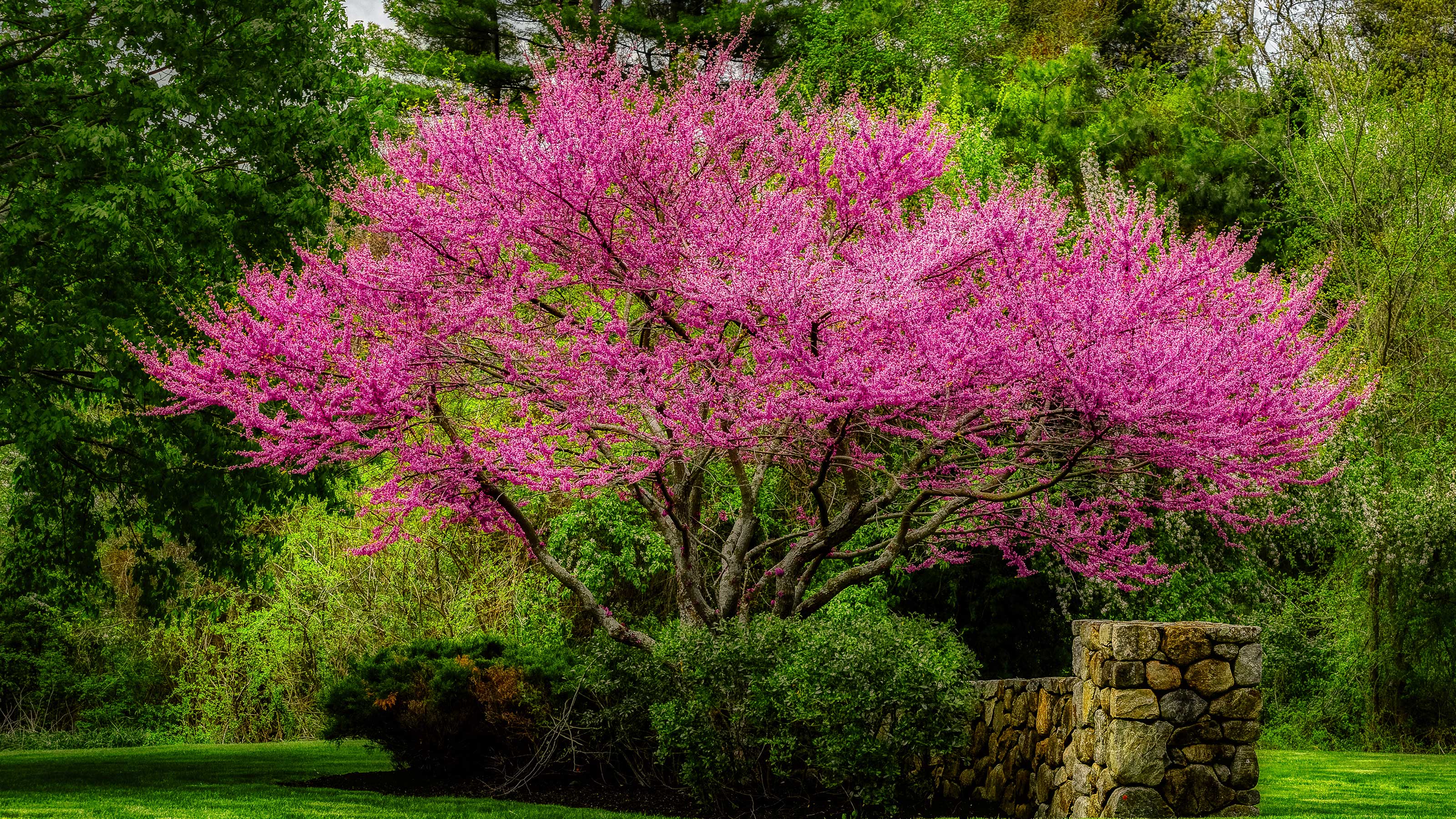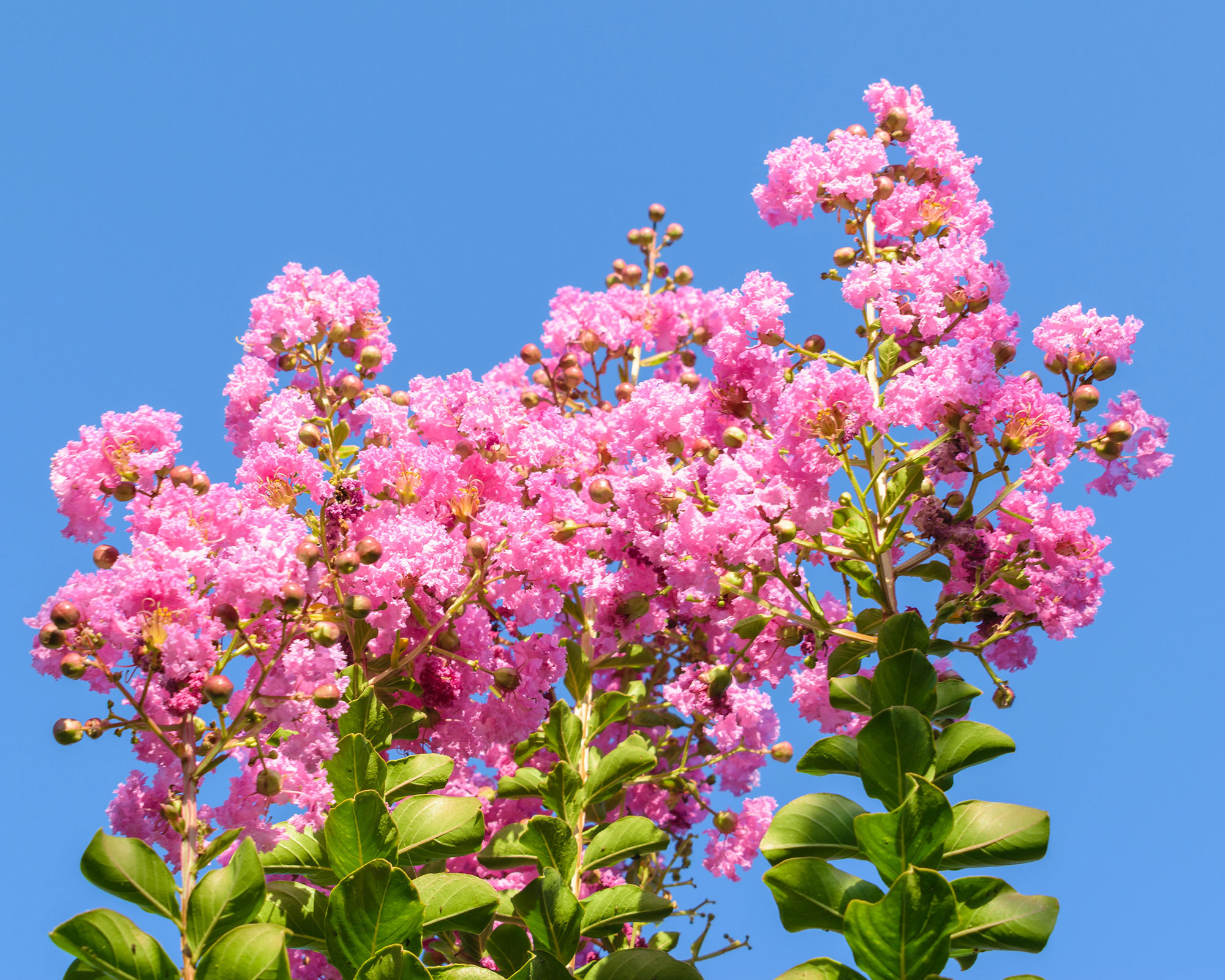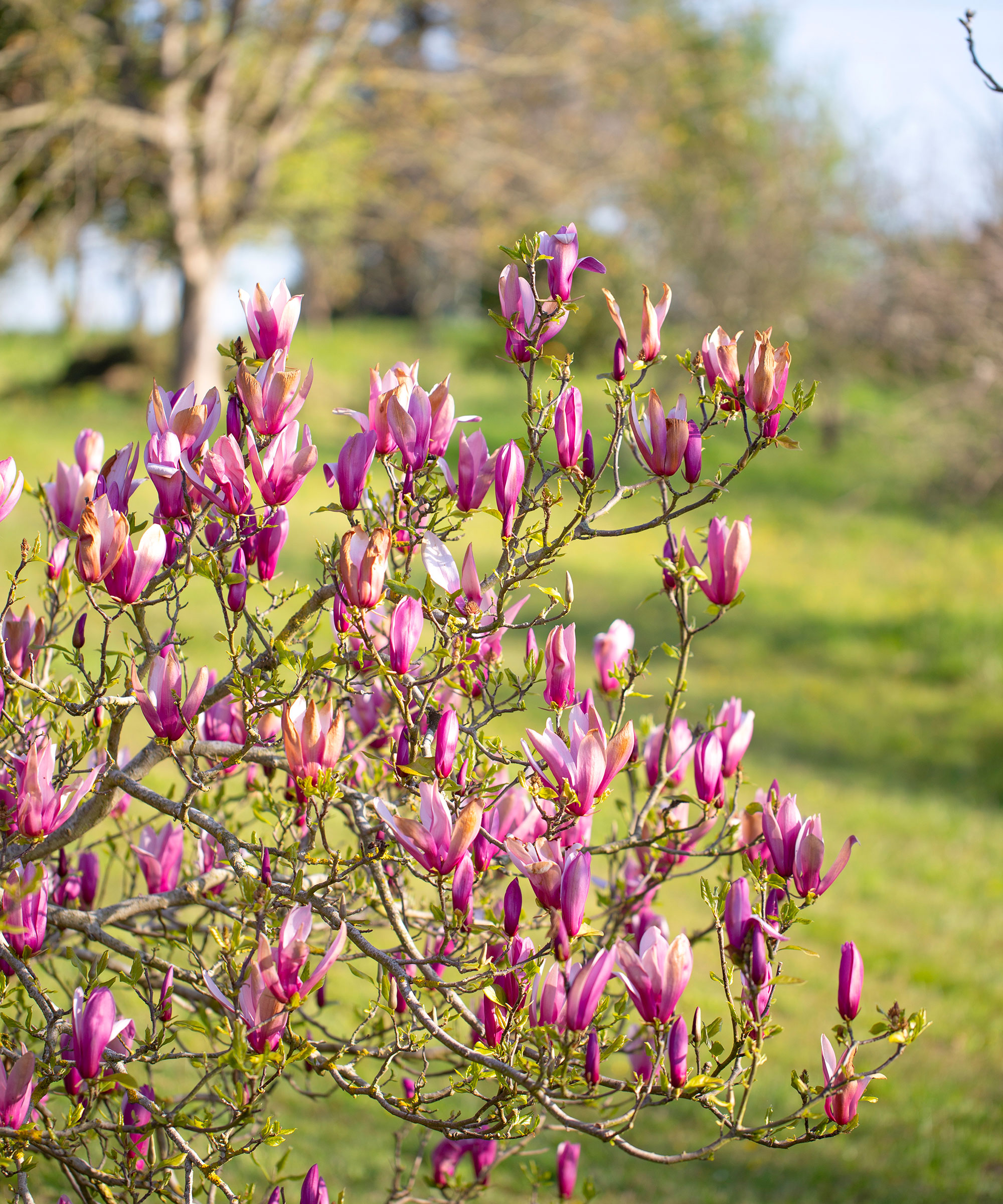Best backyard trees: 10 choices for yards big or small
The best backyard trees will provide shade, privacy, color and interest in any size yard


When selecting the best backyard trees, it is important to choose trees that provide an elegant shape and attractive leaves with, if possible, beautiful flowers or fruits or fall foliage. Your trees are going to be part of your life every day, for many years, so it is important to choose the right variety and plant it in the right place.
Large trees that will soon tower over your house are best avoided, but some varieties develop a tree-like form and still remain quite small. Trees with aggressive roots, such as willows and poplars, are best avoided while some trees have spines or thorns which can give young and tender fingers a nasty surprise.
Varieties with upright growth are generally preferable to trees with more spreading growth, especially if you like to enjoy a lawn, as lawns are difficult to keep looking good in overhead shade from trees, especially evergreen trees. On the other hand, trees that cast cool shade in summer are also valuable if you enjoy relaxing and entertaining outside.
Backyard trees can be expensive, but try to buy the largest available specimen so that it matures before you leave the property for a new home.
Introduce a striking feature to your plot with the best backyard trees
When thinking about your choice of best backyard trees, one of the first questions you'll need to answer is whether you want a deciduous or evergreen variety.
Deciduous trees have the advantage of changing with the seasons, and many have attractive flowers, fruits or fall foliage color. Clearing their leaves in fall can be a chore, but do not think that evergreens never drop their leaves. Leafdrop is simply less noticeable as it happens over a longer period and it can sometimes seem as if evergreens hardly change at all through the year.
If you need to screen a nearby eyesore then an evergreen tree is an obvious choice but even a deciduous tree, although without leaves in winter, can interrupt an ugly view so that it’s always the tree that you notice.
Take your pick from our favorite options.
1. Maple (Acer palmatum)

- Hardiness: USDA 5-8 (UK H6)
- Height: 3-10ft (1-3m)
- Spread: 3-10ft (1-3m)
- Best for: summer and fall foliage color
As one of the best trees for small gardens, this small, rather spreading, deciduous tree is ideal for foliage color in less-than-large backyards. Its leaves are sharply divided into five or seven points, or, in some varieties, repeatedly split into slender lacy segments. In spring and summer the foliage is green, purplish red or yellow then the fiery fall foliage color can be spectacular.
There are many different varieties maturing to a range of heights, but look for ‘Bloodgood’, with crimson leaves in spring and summer followed by fiery red fall color, and also ‘Sango-kaku’, with coral bark and green leaves turning canary yellow.
Best in lime-free soil that is consistently moist but never waterlogged, and in a site that is not exposed to chilly winds.
There's more tips on how to grow acers in our dedicated guide.
2. Birch (Betula)

- Hardiness: USDA 2-8 (UK H7)
- Height: 30+ft (10+m)
- Spread: 10+ft (3+m)
- Best for: casting dappled shade
Birches are invaluable backyard trees. They make elegant specimens, even in winter when their deciduous leaves have fallen and, before they drop, the leaves turn bright yellow.
The bark is often a bright white in color or pinkish or even orange and may peel away prettily. There are also yellow catkins in spring. Birches cast light shade so many plants can be grown beneath them.
Happy on most soils except chalk, the American native river birch, Betula nigra, is the one to grow in damp conditions, look for the variety Heritage (‘Cully’). In drier gardens look for one of the many varieties of Betula pendula, especially the weeping ‘Tristis’.
3. Eastern Redbud (Cercis canadensis)

- Hardiness: USDA 4-9 (UK H5)
- Height: 20-30ft (6-9m)
- Spread: 25-35ft (8-12m)
- Best for: a native deciduous tree
A small, multi-stemmed, native deciduous tree maturing into a rounded specimen, the eastern redbud is unusual in developing its colorful, pink pea-like flowers on the trunk and on large branches as well as at the shoot tips.
The bright buds stud the branches for weeks before opening and in fall the flowers mature to flat pods. The leaves are heart-shaped, and slightly bluish green in color turning yellowish in fall.
There are some special varieties grown for their colorful leaves and these include ‘Forest Pansy’, with deep, reddish purple foliage. Lavender Twist (‘Covey)’, is a neat, weeping variety. Eastern redbud is the state tree of Oklahoma.
4. Lawson Cypress (Chamaecyparis lawsoniana)

- Hardiness: USDA 5-8 (UK H6)
- Height: Depends on variety
- Spread: Depends on variety
- Best for: variety of shapes, sizes and colors
If you're searching for the best trees for privacy, the evergreen Lawson cypress is a very variable evergreen tree. Native to the west coast, where it can develop into pencil-shaped specimens up to 200ft (60m) tall, the many varieties now available come in a large number of shapes and sizes from small, rounded buns to tall and stately spires. It is important to check descriptions and tags to be sure that the variety you choose does the job you need.
The dense, sometimes slightly prickly, sprays of foliage are usually green but may also come in grey, bluish, yellow and golden tones and even variegated.
‘Elwoodii’ is slow growing, its green columns turning bluish in winter. In ‘Ellwood’s Gold’, the tips of the leaves are golden yellow.
Easy in moist but well-drained soils, in sun or partial shade, but unsuitable for waterlogged soils. Trimming is rarely necessary.
5. Japanese Dogwood (Cornus kousa)

- Hardiness: USDA 5-8 (UK H6)
- Height: 15-30ft (4.5-9m)
- Spread: 15-30ft (4.5-9m)
- Best for: spring flowers
Looking for the best flowering trees for your backyard? Japanese dogwood is one of the most flamboyant late spring garden trees. Making upright, vase-like growth in its early years, as it matures it broadens into a more rounded shape. The dark green, deciduous leaves usually turn red in fall but its chief glory is the mass of large, four-petalled white or pink flowers.
Ideal as a lawn specimen, ‘China Girl’ has large flowers, followed by fruits like (inedible) strawberries, and is especially prolific. Samaritan (‘Sanzan’), has the addition of white-edged leaves and is slower growing.
Varieties of Japanese dogwood are resistant to the anthracnose disease that attacks varieties of our native dogwood, Cornus florida.
Growing well in full sun or dappled shade, preferably on acid soils, it appreciates moisture in the height of summer.
6. Crape Myrtle (Lagerstroemia)

- Hardiness: USDA 8-10 (UK H8)
- Height: 10-15ft (3-4.5m)
- Spread: 6-10ft (1.8-3m)
- Best for: hot summers
Not only is the crape myrtle one of the best trees for front yards, it will look just as good in a backyard too.
Crape myrtles are small and medium-sized, rather upright, sometimes multi-stemmed deciduous trees that develop a more rounded look as they mature. The slightly leathery oblong leaves are sometimes tinted red as they first open and often develop fiery tones in fall.
Clusters of papery flowers in a wide range of red, purple and pink tones, plus white, provide a colorful display in mid and late summer and even into fall. Blooming is most prolific in areas with hot summers, and crape myrtles are usually deer resistant.
Many modern varieties remain as neat shrubs, rather than trees, so look for taller varieties such as ‘Tonto’ (magenta pink), 'Muskogee' (lavender) and ‘Catawba’ (purple) which are all disease resistant.
7. Sweet Gum (Liquidambar styraciflua)

- Hardiness: USDA 5-9 (UK H6)
- Height: 40ft (12m)
- Spread: 30ft (9m)
- Best as: a specimen tree or focal point
This handsome deciduous tree, superficially similar to maples but with alternate, rather than opposite leaves, is native to the east and southern USA. As one of the best backyard trees, it features dark and noticeably glossy foliage that is fragrant when crushed and which turns an impressive deep red in fall, or sometimes develops fall foliage color in a blend of fiery shades.
Developing upright, more or less pyramidal, growth first, then spreading more as it matures, it naturally develops a good shape without pruning or trimming.
Develops its best color in lime-free soil and appreciates soil that does not dry out so is a good choice for planting near water. ‘Worplesdon’ has consistently good fall color, ‘Slender Silhouette’ is exceptionally narrow in growth.
You'll find plenty more trees with red leaves in our dedicated guide too.
8. Magnolia

- Hardiness: USDA 5-10 (UK H8)
- Height: Depends on variety
- Spread: Depends on variety
- Best for: tight spaces
Magnolias come in a great variety of shapes and sizes but in a small backyard, where space is tight, choosing the right variety is crucial. Fortunately, some of the best of all magnolias develop into a tall slender shape that is ideal in small spaces.
The deciduous Magnolia ‘Daybreak’ has broad, 9in (23cm) two-tone pink flowers in late spring with a superb scent and is ideal in colder zones (zone 5-8). Later flowering than many of this type, it usually escapes the frosts.
‘D. D. Blanchard’ is evergreen, with 8in (20cm) saucer-shaped, lemon-scented white flowers in late spring and summer and best in the south (zones 7-9). It develops narrowly pyramidal growth and is tougher and more snow resistant than most evergreens.
9. Crab Apple (Malus)

- Hardiness: USDA 4-8 (UK H6)
- Height: 20-30ft (6-9m)
- Spread: 15-25ft (4.5-7.5m)
- Best for: flowers and fruits from the same tree
Trees that give us clouds of flowers in the spring and ornamental fruits in the fall provide two seasons of interest from the same tree. It is like having two different trees in the one place. Crab apples stand out for this combination and some also bring us bronzed foliage.
These are round headed deciduous trees with white, pink or dusky red flowers over several spring weeks followed by small apples in red, gold or yellow. Crab apples will also pollinate your eating apple trees.
Look for the narrowly upright ‘Red Sentinel’, with pink flower buds, white flowers and red fruits that last well into winter or ‘Rudolph’ with red buds, reddish-pink flowers and long-lasting orange fruits plus bronze-tinted leaves.
One of the best trees with berries, they are happy in full sun and in any fertile soil.
10. Arborvitae (Thuya occidentalis)

- Hardiness: USDA 2-8 (UK H8)
- Height: Depends on variety
- Spread: Depends on variety
- Best for: the coldest gardens
This exceptionally hardy evergreen is good as a windbreak, garden screening, or a hedge as well as an upright specimen. The rich dark green foliage, bronzing in winter, has an effective all-year presence and rarely needs trimming.
‘Emerald Green’ (‘Smaragd’) is rich green all year and good as a hedge, screen or a specimen, ‘North Pole’ is similar but is especially resistant to winter burn so best in the coldest areas, ‘Yellow Ribbon’ is golden all year.
Arborvitae is very adaptable and is happy in heavy and light soils, with moist or dry soil, acid or limey. It retains its shape most effectively in plenty of sun.
Which backyard trees are not eaten by deer?
Deer will eat almost anything in winter when food is scarce but for an evergreen try blue spruce (Picea pungens ‘Glauca’), eastern red cedar (Juniperus virginiana), or Japanese plum yew (Cephalotaxus harringtonia).
Or for a deer resistant deciduous tree try magnolias, river birch (Betula nigra), sweet gum (Liquidambar), blackgum (Nyssa sylvatica), American holly (Ilex opaca) or tulip poplar (Liriodendron).

Are there any native trees that are good in backyards?
Yes, natives make some of the best backyard trees and come in a range of sizes. For relatively small native trees for your backyard ideas consider river birch (Betula nigra), eastern Redbud (Cercis canadensis), American fringe tree (Chionanthus virginicus) or evergreen sweetbay magnolia (Magnolia virginiana).
For a larger specimen think about Sweet Gum (Liquidambar styraciflua), Red maple (Acer rubrum) or Blackgum (Nyssa sylvatica).

How do I trim tall backyard trees?
The best answer is: hire an arborist or a tree service to do it for you. Pruning a mature tree is a highly skilled job and you have to live with the consequences for many years after the work is done so it pays to have a trained arborist do it for you. Tree surgery can also be dangerous so it is wise to leave it to someone trained in the necessary skills –and with insurance cover – just in case.
Are some backyard trees invasive?
Yes, there are a few trees that are planted in backyards that can be invasive and are best avoided. In some areas the state has banned planting them. The problem is that their seeds spread and sprout elsewhere in your yard, in your neighbors’ yards, in the street, on the sidewalk, and in wild (and not so wild places) nearby.
In particular avoid planting Black Locust (Robinia pseudoacacia), Callery pear (Pyrus calleryana), Russian olive (Elaeagnus angustifolia) and Tree of heaven (Ailanthus altissima).

Graham Rice is a garden writer who has won awards for his work online, and in books and magazines, on both sides of the Atlantic. He is a member of a number of Royal Horticultural Society committees and the recipient of the 2021 Garden Media Guild Lifetime Achievement Award.
